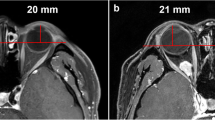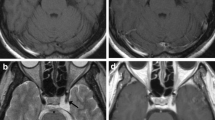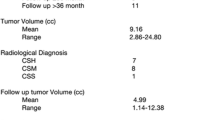Abstract
Purpose
Although rare, orbital cavernous hemangioma (OCH) is the most common benign orbital neoplasm in adults and may cause vision disturbance or loss due to optic nerve compression. The conventional treatment is surgical excision, which carries a risk of intraoperative nerve damage, whereas gamma knife radiosurgery (GKRS) can be a safe and effective alternative. Herein, we report the results of four patients with OCH treated with GKRS, and describe the method of treatment including the optic nerve protection.
Methods
This retrospective study included four consecutive patients (three women, one man; mean age: 50 ± 14.7 years) with OCH treated with single-session GKRS between 2014 and 2020. Three patients had decreased visual acuity. During GKRS, the prescription dose delivered to the tumor margin was 12 Gy at the 55–58% isodose line. The dose to the optic nerve margin was < 12 Gy. Follow-up included sequential magnetic resonance imaging (MRI) and ophthalmological examinations at 6-month intervals.
Results
The median follow-up period was 29.5 ± 23 months (range, 12–63 months). After GKRS, three patients with visual dysfunction had substantial vision improvement; the fourth patient continued to have normal vision without deterioration. Radiological outcomes after GKRS indicated an average tumor shrinkage of 70% ± 10.6% at the 6-month follow-up and 83% ± 2.64% at the 1-year follow-up. No adverse radiation effects were observed.
Conclusions
GKRS for OCH achieved favorable clinical outcomes, with substantial tumor volume reduction. OCH can be diagnosed based on characteristic MRI findings. GKRS may be considered a treatment option for OCH in selected cases.




Similar content being viewed by others
Data Availability
The datasets generated during and/or analysed during the current study are available from the corresponding author on reasonable request.
References
Shields JA, Shields CL, Scartozzi R (2004) Survey of 1264 patients with orbital tumors and simulating lesions: the 2002 Montgomery Lecture, part 1. Ophthalmology 111:997–1008. https://doi.org/10.1016/j.ophtha.2003.01.002
Ansari SA, Mafee MF (2005) Orbital cavernous hemangioma: role of imaging. Neuroimaging Clin N Am 15:137–158. doi:https://doi.org/10.1016/j.nic.2005.02.009
Smoker WR, Gentry LR, Yee NK, Reede DL, Nerad JA (2008) Vascular lesions of the orbit: more than meets the eye. Radiographics 28:185–204. doi:https://doi.org/10.1148/rg.281075040 quiz 325
Liu X, Xu D, Zhang Y, Liu D, Song G (2010) Gamma Knife surgery in patients harboring orbital cavernous hemangiomas that were diagnosed on the basis of imaging findings. J Neurosurg 113:39–43. doi:https://doi.org/10.3171/2010.7.Gks10963
Zhou W, Zhu YM, Su ZZ, Pan F (2013) [agnetic resonance imaging diagnosis and microsurgical treatment of cavernous sinus hemangiomas. Zhongguo Yi Xue Ke Xue Yuan Xue Bao 35:677–682. https://doi.org/10.3881/j.issn.1000-503X.2013.06.017
Tanaka A, Mihara F, Yoshiura T, Togao O, Kuwabara Y, Natori Y, Sasaki T, Honda H (2004) Differentiation of cavernous hemangioma from schwannoma of the orbit: a dynamic MRI study. AJR Am J Roentgenol 183:1799–1804. doi:https://doi.org/10.2214/ajr.183.6.01831799
Xian J, Zhang Z, Wang Z, Li J, Yang B, Chen Q, Chang Q, He L (2010) Evaluation of MR imaging findings differentiating cavernous haemangiomas from schwannomas in the orbit. Eur Radiol 20:2221–2228. doi:https://doi.org/10.1007/s00330-010-1774-y
Gonzalez LF, Lekovic GP, Eschbacher J, Coons S, Porter RW, Spetzler RF (2006) Are cavernous sinus hemangiomas and cavernous malformations different entities? Neurosurg Focus 21:e6. doi:https://doi.org/10.3171/foc.2006.21.1.7
Rootman DB, Heran MK, Rootman J, White VA, Luemsamran P, Yucel YH (2014) Cavernous venous malformations of the orbit (so-called cavernous haemangioma): a comprehensive evaluation of their clinical, imaging and histologic nature. Br J Ophthalmol 98:880–888. doi:https://doi.org/10.1136/bjophthalmol-2013-304460
Wu ZY, Yan JH, Han J, Yang HS, Lin Z, Chen ZC, Ai SM, Mao YX (2006) Diagnosis and surgical management of 209 cases of orbital cavernous hemangioma. Zhonghua Yan Ke Za Zhi 42:323–325
Yan J, Wu Z (2004) Cavernous hemangioma of the orbit: analysis of 214 cases. Orbit 23:33–40. doi:https://doi.org/10.1076/orbi.23.1.33.28992
Aymard PA, Langlois B, Putterman M, Jacomet PV, Morax S, Galatoire O (2013) Management of orbital cavernous hemangioma - evaluation of surgical approaches: report of 43 cases. J Fr Ophtalmol 36:820–829. https://doi.org/10.1016/j.jfo.2013.04.009
Chen L, White WL, Xu B, Tian X (2010) Transnasal transsphenoid approach: a minimally invasive approach for removal of cavernous haemangiomas located at inferomedial part of orbital apex. Clin Exp Ophthalmol 38:439–443. doi:https://doi.org/10.1111/j.1442-9071.2010.02274.x
Rootman DB, Rootman J, Gregory S, Feldman KA, Ma R (2012) Stereotactic fractionated radiotherapy for cavernous venous malformations (hemangioma) of the orbit. Ophthalmic Plast Reconstr Surg 28:96–102. doi:https://doi.org/10.1097/IOP.0b013e31824a48f3
Kim MS, Park K, Kim JH, Kim YD, Lee JI (2008) Gamma knife radiosurgery for orbital tumors. Clin Neurol Neurosurg 110:1003–1007. doi:https://doi.org/10.1016/j.clineuro.2008.06.008
Calandriello L, Grimaldi G, Petrone G, Rigante M, Petroni S, Riso M, Savino G (2017) Cavernous venous malformation (cavernous hemangioma) of the orbit: current concepts and a review of the literature. Surv Ophthalmol 62:393–403. https://doi.org/10.1016/j.survophthal.2017.01.004
Ares WJ, Flickinger JC, Lunsford LD (2019) Leksell radiosurgery for orbital, uveal, and choroidal tumors. Prog Neurol Surg 34:298–305. https://doi.org/10.1159/000493077
Johnson S, Niranjan A, Kano H, Lunsford LD (2019) Leksell radiosurgery for the 3 H tumors: hemangiomas, hemangioblastomas, and hemangiopericytomas. Prog Neurol Surg 34:223–231. https://doi.org/10.1159/000493068
Khan AA, Niranjan A, Kano H, Kondziolka D, Flickinger JC, Lunsford LD (2009) Stereotactic radiosurgery for cavernous sinus or orbital hemangiomas. Neurosurgery 65:914–918. doi:https://doi.org/10.1227/01.NEU.0000356987.98197.71 discussion 918
Kim CY, Lee SY (2012) Orbital paraganglioma: gamma knife surgery as a therapeutic option. J Craniofac Surg 23:1127–1128. doi:https://doi.org/10.1097/SCS.0b013e31824e5c99
Xu D, Liu D, Zhang Z, Zhang Y, Li Y, Liu X, Jia Q, Zheng L, Song G (2010) Gamma Knife surgery in the management of orbital tumors. J Neurosurg 113 Suppl:34–38. doi:https://doi.org/10.3171/2010.7.GKS10857
Kim BS, Im YS, Woo KI, Kim YD, Lee JI (2015) Multisession gamma knife radiosurgery for orbital apex tumors. World Neurosurg 84:1005–1013. https://doi.org/10.1016/j.wneu.2015.04.042
Goh ASC, Kim YD, Woo KI, Lee JI (2013) Benign orbital apex tumors treated with multisession gamma knife radiosurgery. Ophthalmology 120:635–641. doi:https://doi.org/10.1016/j.ophtha.2012.08.015
Jo KI, Im YS, Kong DS, Seol HJ, Nam DH, Kim YD, Lee JI (2012) Multisession Gamma Knife surgery for benign orbital tumors. J Neurosurg 117 Suppl:102–107. doi:https://doi.org/10.3171/2012.7.GKS12780
Harris GJ, Jakobiec FA (1979) Cavernous hemangioma of the orbit. J Neurosurg 51:219–228. doi:https://doi.org/10.3171/jns.1979.51.2.0219
Di Tommaso L, Scarpellini F, Salvi F, Ragazzini T, Foschini MP (2000) Progesterone receptor expression in orbital cavernous hemangiomas. Virchows Arch 436:284–288. doi:https://doi.org/10.1007/s004280050042
Scheuerle AF, Steiner HH, Kolling G, Kunze S, Aschoff A (2004) Treatment and long-term outcome of patients with orbital cavernomas. Am J Ophthalmol 138:237–244. doi:https://doi.org/10.1016/j.ajo.2004.03.011
Darsaut TE, Lanzino G, Lopes MB, Newman S (2001) An introductory overview of orbital tumors. Neurosurg Focus 10:E1. doi:https://doi.org/10.3171/foc.2001.10.5.2
Bachelet JT, Berhouma M, Shipkov H, Kodjikian L, Jouanneau E, Gleizal A (2018) Orbital cavernous hemangioma causing spontaneous compressive hemorrhage. J Craniofac Surg 29:706–708. https://doi.org/10.1097/SCS.0000000000004285
McNab AA (2014) Nontraumatic orbital hemorrhage. Surv Ophthalmol 59:166–184. doi:https://doi.org/10.1016/j.survophthal.2013.07.002
Arora V, Prat MC, Kazim M (2011) Acute presentation of cavernous hemangioma of the orbit. Orbit 30:195–197. doi:https://doi.org/10.3109/01676830.2011.579684
Yamamoto J, Takahashi M, Nakano Y, Saito T, Kitagawa T, Ueta K, Miyaoka R, Nishizawa S (2012) Spontaneous hemorrhage from orbital cavernous hemangioma resulting in sudden onset of ophthalmopathy in an adult–case report. Neurol Med Chir (Tokyo) 52:741–744. doi:https://doi.org/10.2176/nmc.52.741
Young SM, Kim YD, Lee JH, Woo KI (2018) Radiological analysis of orbital cavernous hemangiomas: a review and comparison between computed tomography and magnetic resonance imaging. J Craniofac Surg 29:712–716. https://doi.org/10.1097/SCS.0000000000004291
Fries PD, Char DH, Norman D (1987) MR imaging of orbital cavernous hemangioma. J Comput Assist Tomogr 11:418–421. doi:https://doi.org/10.1097/00004728-198705000-00009
Rootman J (2003) Vascular malformations of the orbit: hemodynamic concepts. Orbit 22:103–120. doi:https://doi.org/10.1076/orbi.22.2.103.14311
Poon CS, Sze G, Johnson MH (2008) Orbital lesions: differentiating vascular and nonvascular etiologic factors. AJR Am J Roentgenol 190:956–965. doi:https://doi.org/10.2214/AJR.07.3117
Thompson TP, Lunsford LD, Flickinger JC (2000) Radiosurgery for hemangiomas of the cavernous sinus and orbit: technical case report. Neurosurgery 47:778–783. doi:https://doi.org/10.1097/00006123-200009000-00052
Young SM, Kim KH, Kim YD, Lang SS, Park JW, Woo KI, Lee JI (2019) Orbital apex venous cavernous malformation with optic neuropathy: treatment with multisession gamma knife radiosurgery. Br J Ophthalmol 103:1453–1459. doi:https://doi.org/10.1136/bjophthalmol-2018-312893
Lee WJ, Cho KR, Choi JW, Kong DS, Seol HJ, Nam DH, Kim YD, Woo KI, Lee JI (2020) Stereotactic radiosurgery for orbital cavernous venous malformation: a single center’s experience for 15 years. Acta Neurochir (Wien). doi:https://doi.org/10.1007/s00701-020-04575-4
Mayo C, Martel MK, Marks LB, Flickinger J, Nam J, Kirkpatrick J (2010) Radiation dose-volume effects of optic nerves and chiasm. Int J Radiat Oncol Biol Phys 76:S28–S35. doi:https://doi.org/10.1016/j.ijrobp.2009.07.1753
Stafford SL, Pollock BE, Leavitt JA, Foote RL, Brown PD, Link MJ, Gorman DA, Schomberg PJ (2003) A study on the radiation tolerance of the optic nerves and chiasm after stereotactic radiosurgery. Int J Radiat Oncol Biol Phys 55:1177–1181. doi:https://doi.org/10.1016/s0360-3016(02)04380-8
Yamamoto M, Kida Y, Fukuoka S, Iwai Y, Jokura H, Akabane A, Serizawa T (2010) Gamma Knife radiosurgery for hemangiomas of the cavernous sinus: a seven-institute study in Japan. J Neurosurg 112:772–779. doi:https://doi.org/10.3171/2009.6.JNS08271
Chou CW, Wu HM, Huang CI, Chung WY, Guo WY, Shih YH, Lee LS, Pan DH (2010) Gamma knife surgery for cavernous hemangiomas in the cavernous sinus. Neurosurgery 67:611–616. https://doi.org/10.1227/01.NEU.0000378026.23116.E6 (discussion 616)
Funding
No funding was received to assist with the preparation of this manuscript.
Author information
Authors and Affiliations
Contributions
All authors contributed to the study conception and design. Material preparation, data collection and analysis were performed by Hsien-Chung Chen, Chaur-Jong Hu and David Hung-Chi Pan. The first draft of the manuscript was written by Hsien-Chung Chen and all authors commented on previous versions of the manuscript. All authors read and approved the final manuscript.
Corresponding author
Ethics declarations
Conflict of interest
All authors declare that they have no conflict of interest to disclose.
Consent to publish
Patients signed informed consent regarding publishing their data and photographs.
Consent to participate
Verbal informed consent was obtained from the patients.
Ethical approval
All procedures performed in studies involving human participants were in accordance with the ethical standards of the institutional and/or national research committee and with the 1964 Helsinki Declaration and its later amendments or comparable ethical standards. The above study has been approved by expedited review process of the TMU-Joint Institutional Review Board in meeting #109-01-3(date:2020/01/21), duration of validity is from 2020/01/17 to 2021/01/16. The number of IRB is N201912074 and the inform consent is waived.
Additional information
Publisher’s note
Springer Nature remains neutral with regard to jurisdictional claims in published maps and institutional affiliations.
Rights and permissions
About this article
Cite this article
Chen, HC., Hu, CJ. & Pan, D.HC. Stereotactic gamma knife radiosurgery for orbital cavernous hemangioma: clinical outcome and visual function protection. J Neurooncol 152, 183–193 (2021). https://doi.org/10.1007/s11060-020-03692-5
Received:
Revised:
Accepted:
Published:
Issue Date:
DOI: https://doi.org/10.1007/s11060-020-03692-5




